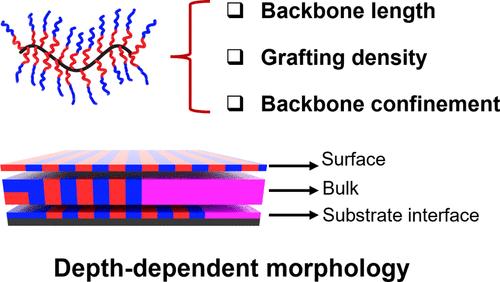Bottlebrush Block Copolymer Thin Films
IF 5.2
1区 化学
Q1 POLYMER SCIENCE
引用次数: 0
Abstract
The self-assembly of block copolymers (BCPs) in thin films is governed by interfacial interactions (enthalpy) between the blocks and interfaces (at both the substrate and the surface). Advantage can also be taken of entropy to control the polymer orientation. Here, we synthesized a series of bottlebrush block copolymers (BBCPs), with deuterated polystyrene (DPS) as the core block and poly(solketal acrylate) (PSA) as the corona block, where the backbone length (NBB) and grafting densities (GDs) were varied. The hydrophobic PSA block was converted to a hydrophilic poly(glyceryl acrylate) (PGA) block by solid-state hydrolysis, bringing the BBCP from a disordered state into an ordered state with a lamellar microdomain morphology. The orientation of the morphology as a function of distance from the interfaces was systematically investigated by atomic force microscopy (AFM), interference microscopy, grazing-incidence small-angle X-ray scattering (GISAXS), and grazing-incidence small angle neutron scattering (GISANS). For NBB = 1 (diblock BCP), a mixed lamellar orientation was found. For NBB = 5 (star-like BBCP), a vertical orientation of the lamellar microdomains was found dominantly at the interfaces that propagated into the bulk of the film due to the entropic penalty associated with constraints on the junction points. Increasing the NBB to 50 (rod-like BBCP) and 100 (worm-like BBCP) yielded a random orientation, as the side chains became overcrowded when aligned in the same direction. By reducing the grafting density (GD) of a NBB = 50 BBCP from 100% to 75% and 50% by the incorporation of spacers into the backbone, the steric hindrance of side chains is reduced markedly, facilitating a vertical orientation of the lamellar microdomains. However, the vertical orientation becomes more random within the bulk of the thin film for different BBCP architectures. By modifying the substrate with a layer of PS, the preferential interactions between the core block of the BBCP and the interfaces induce a reconfiguration of the BBCP, drawing the core block out to contact substrate directly driven by enthalpy. Under these conditions, NBB = 5 showed a predominantly parallel orientation of the lamellar microdomains with the corona block minimizing contact with the substrate. Higher NBB values of 50 and 100 showed a more random orientation of the lamellar microdomains at different depths on the PS-modified substrate. Overall, thin-film morphology was regulated by tuning the configuration of the BBCP, varying the entropic contribution to the microdomain orientation.

瓶刷嵌段共聚物薄膜
嵌段共聚物(bcp)在薄膜中的自组装是由嵌段和界面(在衬底和表面)之间的界面相互作用(焓)控制的。还可以利用熵的优势来控制聚合物的取向。本文以氘化聚苯乙烯(DPS)为核心嵌段,聚丙烯酸溶胶(PSA)为电晕嵌段,合成了不同骨架长度(NBB)和接枝密度(GDs)的瓶刷嵌段共聚物(BBCPs)。通过固态水解将疏水性PSA块转化为亲水性聚丙烯酸甘油酯(PGA)块,使BBCP从无序状态变为具有层状微畴形态的有序状态。利用原子力显微镜(AFM)、干涉显微镜、掠射小角x射线散射(GISAXS)和掠射小角中子散射(GISANS)系统地研究了形貌取向与界面距离的关系。当NBB = 1(双块BCP)时,发现混合层状取向。当NBB = 5(星状BBCP)时,由于结合点约束相关的熵罚,层状微畴的垂直方向主要分布在传播到薄膜主体的界面上。将NBB增加到50(棒状BBCP)和100(蠕虫状BBCP)会产生随机方向,因为侧链在同一方向排列时会变得过于拥挤。通过将NBB = 50 BBCP的接枝密度(GD)从100%降低到75%,并通过在骨架中加入间隔剂将接枝密度(GD)降低到50%,侧链的空间位阻明显降低,有利于层状微畴的垂直取向。然而,对于不同的BBCP结构,垂直方向在薄膜内部变得更加随机。通过在衬底上添加一层PS, BBCP的核心块与界面之间的优先相互作用诱导BBCP重新配置,并在焓的驱动下将核心块直接拉出与衬底接触。在这些条件下,NBB = 5显示出片层微畴的主要平行取向,电晕块与衬底的接触最小。较高的NBB值为50和100,表明ps修饰的衬底上不同深度的层状微畴取向更加随机。总的来说,通过调整BBCP的结构来调节薄膜的形态,改变微畴取向的熵贡献。
本文章由计算机程序翻译,如有差异,请以英文原文为准。
求助全文
约1分钟内获得全文
求助全文
来源期刊

Macromolecules
工程技术-高分子科学
CiteScore
9.30
自引率
16.40%
发文量
942
审稿时长
2 months
期刊介绍:
Macromolecules publishes original, fundamental, and impactful research on all aspects of polymer science. Topics of interest include synthesis (e.g., controlled polymerizations, polymerization catalysis, post polymerization modification, new monomer structures and polymer architectures, and polymerization mechanisms/kinetics analysis); phase behavior, thermodynamics, dynamic, and ordering/disordering phenomena (e.g., self-assembly, gelation, crystallization, solution/melt/solid-state characteristics); structure and properties (e.g., mechanical and rheological properties, surface/interfacial characteristics, electronic and transport properties); new state of the art characterization (e.g., spectroscopy, scattering, microscopy, rheology), simulation (e.g., Monte Carlo, molecular dynamics, multi-scale/coarse-grained modeling), and theoretical methods. Renewable/sustainable polymers, polymer networks, responsive polymers, electro-, magneto- and opto-active macromolecules, inorganic polymers, charge-transporting polymers (ion-containing, semiconducting, and conducting), nanostructured polymers, and polymer composites are also of interest. Typical papers published in Macromolecules showcase important and innovative concepts, experimental methods/observations, and theoretical/computational approaches that demonstrate a fundamental advance in the understanding of polymers.
 求助内容:
求助内容: 应助结果提醒方式:
应助结果提醒方式:


